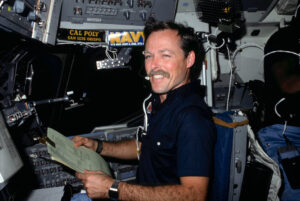
 Our space program has gone through many changes over the years. There have been accidents, losses, victories, and amazing strides in both exploration and the vehicles we use to take these trips. One of the biggest goals was to have a space station so that men and women could live and work in space indefinitely…or at least for long periods of time. On June 29, 1995, the American space shuttle Atlantis docked with the Russian space station Mir. This docking formed the largest man-made satellite ever to orbit the Earth…at that time, anyway. We all know that records are meant to be broken.
Our space program has gone through many changes over the years. There have been accidents, losses, victories, and amazing strides in both exploration and the vehicles we use to take these trips. One of the biggest goals was to have a space station so that men and women could live and work in space indefinitely…or at least for long periods of time. On June 29, 1995, the American space shuttle Atlantis docked with the Russian space station Mir. This docking formed the largest man-made satellite ever to orbit the Earth…at that time, anyway. We all know that records are meant to be broken.
For a number of years, Russia and the United States had been rivals when it came to the Space Race…as well as many other things, so this joint venture was a really big deal. It was not only about the two rivals working in cooperation together, but it was also the 100th human space mission in American history. It was such a big deal, in fact, that Daniel Goldin, chief of the National Aeronautics and Space Administration (NASA), called it the beginning of “a new era of friendship and cooperation” between the United States and Russia. The docking was also a big deal to people everywhere, with millions of viewers watching on television, Atlantis blasted off from NASA’s Kennedy Space Center in eastern Florida on June 27, 1995.
Just after 6am on June 29, the very excited seven-member crew prepared Atlantis for docking with Mir, as both crafts orbited the Earth some 245 miles above Central Asia, near the Russian-Mongolian border. The moment they spotted the shuttle, the three cosmonauts on Mir began to broadcast Russian folk songs to Atlantis to welcome them. The party was about to begin. Over the next two hours, the shuttle’s commander, Robert “Hoot” Gibson expertly maneuvered his craft towards the space station. This was no easy task. In order to make the docking, Gibson had to steer the 100-ton shuttle to within three inches of Mir at a closing rate of no more than one foot every 10 seconds. Now, I don’t know how fast that would be in miles per hour measurement, but I think these crafts could certainly be damaged by the impact. Precision was key.
Well, the docking went perfectly that day, and by 8am it was completed, and just two seconds off the targeted arrival time, while using 200 pounds less fuel than had been anticipated. Now, that’s what I call success. When docked, Atlantis and the 123-ton Mir formed the largest spacecraft ever in orbit at that time. It was only the second time ships from two countries had linked up in space; the first was in June 1975, when an American Apollo capsule and a Soviet Soyuz spacecraft briefly joined in orbit.
Once the docking was completed, Gibson and Mir’s commander, Vladimir Dezhurov, greeted each other by clasping hands in a victorious celebration of the historic moment. A formal exchange of gifts followed, with the Atlantis crew bringing chocolate, fruit, and flowers and the Mir cosmonauts offering traditional Russian welcoming gifts of bread and salt. After the party, Atlantis remained docked with Mir for five days before returning to Earth. They left two fresh Russian cosmonauts behind on the space station and took the three veteran Mir crew members home in the shuttle. The returning crew members included two Russians and 
 Norman Thagard, a US astronaut who rode a Russian rocket to the space station in mid-March 1995 and spent over 100 days in space. This was a United States endurance record…at that time, anyway. This was a great alliance, especially between two former rivals. NASA’s Shuttle-Mir program continued for 11 missions and was a crucial step towards the construction of the International Space Station, which is now in orbit, and is the current largest space craft.
Norman Thagard, a US astronaut who rode a Russian rocket to the space station in mid-March 1995 and spent over 100 days in space. This was a United States endurance record…at that time, anyway. This was a great alliance, especially between two former rivals. NASA’s Shuttle-Mir program continued for 11 missions and was a crucial step towards the construction of the International Space Station, which is now in orbit, and is the current largest space craft.


Leave a Reply